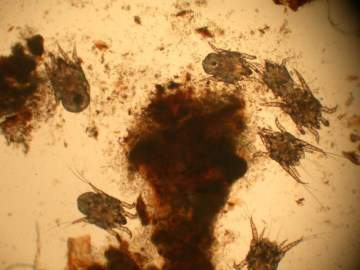Yorkie Ear Mites
Overview
Ear Mites are not a fun subject. However, it is a very important one. The problem with dog ear mites is that:
- They are very contagious
- It causes a dog great discomfort
- They can move to other areas of the dog if not treated
- A dog needs to be treated by a veterinarian to receive the proper medication to kill them off
Let's discuss:
- Exactly what ear mites are
- Symptoms
- Treatment
- Prevention
What Exactly Are Ear Mites?
Ear mites are the most widespread mite that infests dogs and they are very transmittable, easily spreading from dog to dog or other animal to dog.
Ear mites are little crab-like parasites that reside in the ear canals and head of dogs, and despite the name, they can also sometimes be found throughout a dog's coat and skin. There can be thousands of mites inside of a Yorkie’s ear.
They begin by living on the surface of the dog’s ear canal. Different than fleas, they do not prick the skin or suck the dog’s blood. It is usually starting in a dog's ear that they eat the tiny amounts of a skin tissue and ear fluid. As time goes by, they can travel
to the dog’s back, neck and all over the body.
Mites have 4 phases to their life cycle. They are hard to get rid of because even though the adults will die off within 4 weeks, mites in other stages will be on the dog and will rapidly be maturing into more adults that will eat away at tissue.
If a Yorkie does have mites, you can be sure that they are present in all for growth cycles:
Signs and Symptoms
Since ear mites are so minuscule, it's very hard to see them with the naked eye. During early infection, you'll notice the main symptoms. The signs of ear mites include:
- Swelling in a Yorkie’s ears, this is sometimes extreme
- Irritation and scratching, which may be confused with allergies
- An increase of earwax, this may be thicker than normal
- Ear discharge, this is usually very thick and can be the color black
- There may be a bad smell
coming from the ears
- The dog will have intense itching and will do all he can to scratch his ears
- In an attempt to stop the terrible irritation, a dog will usually shake their head quite a bit
- There may be an open or a crusted sore at the base of the ear
How Does a Dog Catch Mites?
Although a dog may catch ear mites at any age, this does happen more frequently with puppies. The reason is that they have not yet built immunity.
This is very contagious and if any dog or other animal that has ear mites comes into contact with your Yorkie, your dog may then have them.
We've had many owners ask if they can catch ear mites from their Yorkie. Technically, yes. Though, if they are transferred from your Yorkshire Terrier to you, they will usually be on your hands, wrists or arms. They may start taking tiny bites of your skin, which often causes a rash. It would be rare for them to travel all the way to your own ears.
It is suggested to keep away from at-home remedies and inexpensive over-the-counter treatments since these often only kill the adults and do nothing in regard to all of the eggs and larvae.
Because ear mites are extremely contagious, all other pets (any type) should be examined and treated at the same time.
If you have more than one pet and only one has been diagnosed for ear mites, be sure to wash all bedding and any other washable items in your home.
Prevention
1) It can help to thoroughly dry your Yorkie’s ears after baths and to always check for foreign matter in the ears while you are
grooming.
2) If your Yorkie is near another dog or cat
and you see that the animal s scratching his ears or has other signs which make you suspect a possible ear mite infection, distance your Yorkie from him/her.
3) Taking your Yorkie to the vet as soon as you suspect mites is the best course of action for a speedy recovery.
Looking for More Information?
Not a problem! The YorkieInfoCenter Team has put together the most helpful, comprehensive Yorkshire Terrier book that exists. This new, 4th version in both Print & eBook, has it all.


